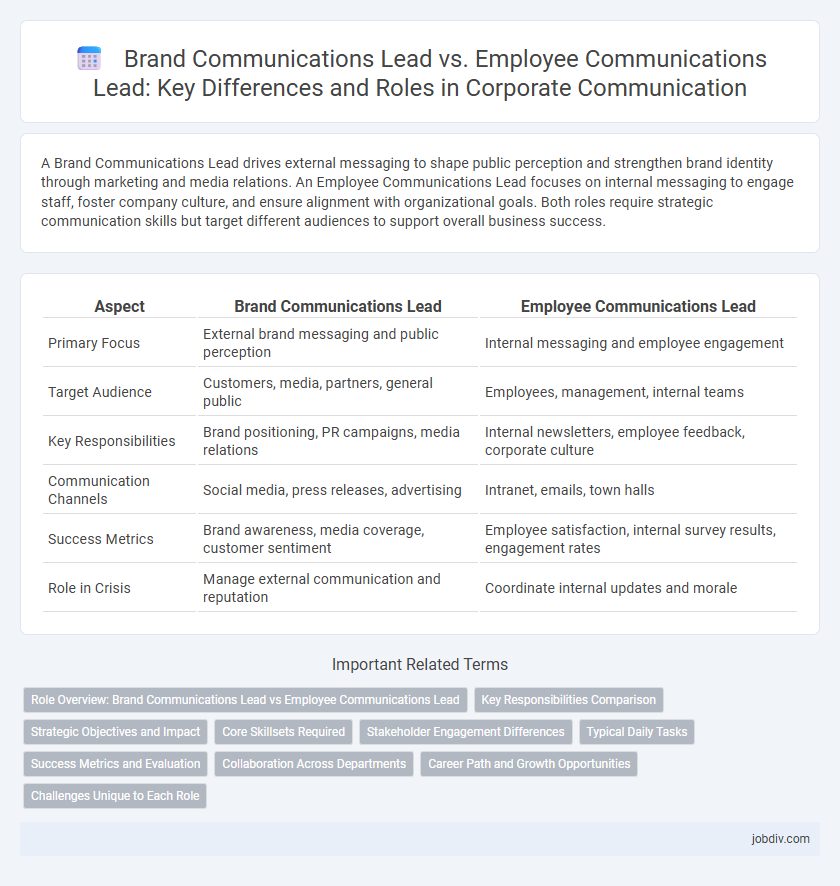A Brand Communications Lead drives external messaging to shape public perception and strengthen brand identity through marketing and media relations. An Employee Communications Lead focuses on internal messaging to engage staff, foster company culture, and ensure alignment with organizational goals. Both roles require strategic communication skills but target different audiences to support overall business success.
Table of Comparison
| Aspect | Brand Communications Lead | Employee Communications Lead |
|---|---|---|
| Primary Focus | External brand messaging and public perception | Internal messaging and employee engagement |
| Target Audience | Customers, media, partners, general public | Employees, management, internal teams |
| Key Responsibilities | Brand positioning, PR campaigns, media relations | Internal newsletters, employee feedback, corporate culture |
| Communication Channels | Social media, press releases, advertising | Intranet, emails, town halls |
| Success Metrics | Brand awareness, media coverage, customer sentiment | Employee satisfaction, internal survey results, engagement rates |
| Role in Crisis | Manage external communication and reputation | Coordinate internal updates and morale |
Role Overview: Brand Communications Lead vs Employee Communications Lead
The Brand Communications Lead focuses on shaping and promoting the company's external image through strategic messaging, media relations, and marketing campaigns, ensuring consistent brand identity across all platforms. The Employee Communications Lead centers on internal communication strategies, fostering engagement, alignment, and transparency among employees via newsletters, events, and leadership messaging. Both roles require expertise in communication management but target distinct audiences to support organizational goals effectively.
Key Responsibilities Comparison
The Brand Communications Lead oversees external messaging, ensuring brand consistency across advertising, public relations, and digital channels to enhance company reputation and market positioning. The Employee Communications Lead focuses on internal communication strategies, fostering engagement, and aligning messaging with corporate culture and employee experience. Both roles require strategic planning and collaboration but differ in target audiences and communication objectives.
Strategic Objectives and Impact
A Brand Communications Lead drives strategic objectives centered on enhancing brand awareness, reputation management, and external stakeholder engagement to influence market positioning and customer perception. An Employee Communications Lead focuses on internal alignment, promoting organizational culture, and facilitating transparent information flow to boost employee engagement and productivity. Both roles impact overall business performance but target distinct audiences through tailored communication strategies.
Core Skillsets Required
Brand Communications Leads require expertise in strategic messaging, media relations, and brand identity development to effectively shape public perception and maintain brand consistency across channels. Employee Communications Leads must excel in internal communication strategies, change management, and employee engagement to foster a transparent and motivated workplace culture. Both roles demand strong storytelling abilities and stakeholder management, but their core skillsets diverge around external versus internal audience focus.
Stakeholder Engagement Differences
Brand Communications Leads primarily engage external stakeholders such as customers, partners, and media to build brand equity and drive market positioning. Employee Communications Leads focus on internal stakeholders, including staff and management, to foster workplace culture, employee engagement, and alignment with organizational values. The difference in stakeholder engagement lies in the Brand Communications Lead targeting outward-facing relationships, while the Employee Communications Lead prioritizes internal communication flows and employee experience.
Typical Daily Tasks
A Brand Communications Lead typically manages external messaging strategies, oversees media relations, and crafts content that aligns with brand identity to enhance public perception. An Employee Communications Lead focuses on internal communication channels, develops engagement initiatives, and facilitates information flow between leadership and staff to boost workplace morale. Both roles require strategic planning and collaboration but differ in audience targeting and communication objectives.
Success Metrics and Evaluation
Brand Communications Leads prioritize success metrics such as brand awareness, market penetration, and customer engagement rates, using tools like social media analytics, brand sentiment analysis, and campaign ROI to evaluate effectiveness. Employee Communications Leads focus on internal success metrics including employee engagement scores, message reach, and feedback quality, leveraging surveys, pulse checks, and intranet analytics to assess communication impact. Both roles require data-driven evaluation but differ in target audiences and performance indicators tied to external brand presence versus internal organizational alignment.
Collaboration Across Departments
Brand Communications Leads collaborate with marketing, product, and sales teams to ensure consistent messaging aligned with the company's brand strategy. Employee Communications Leads work closely with HR, internal teams, and leadership to foster engagement and clarity around internal initiatives and corporate culture. Effective collaboration across these departments streamlines communication efforts and enhances overall organizational alignment.
Career Path and Growth Opportunities
Brand Communications Lead primarily focuses on external messaging, managing public relations, media strategies, and brand reputation to drive market presence, often progressing towards senior marketing or chief communications roles. Employee Communications Lead specializes in internal communications, fostering company culture and employee engagement, paving the way for advancement into human resources leadership or organizational development positions. Both career paths offer unique growth opportunities, with Brand Communications emphasizing external influence and Employee Communications centering on internal stakeholder collaboration.
Challenges Unique to Each Role
Brand Communications Leads face the challenge of maintaining consistent messaging across diverse platforms to build a strong public image while managing brand reputation. Employee Communications Leads must navigate internal cultural dynamics and ensure transparent information flow to enhance employee engagement and alignment. Both roles demand strategic communication skills but require tailored approaches to address external perception versus internal cohesion.
Brand Communications Lead vs Employee Communications Lead Infographic

 jobdiv.com
jobdiv.com